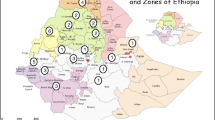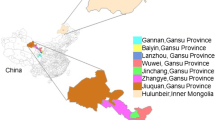Abstract
Puccinia striiformis is the causal pathogen for stripe (yellow) rust of cereals. Puccinia striiformis f. sp. tritici causing wheat stripe rust and a variant of P. striiformis causing barley grass stripe rust (BGYR) are endemic to Australia. Puccinia striiformis f. sp. hordei causing barley stripe rust is exotic and a potential threat to the Australian barley industry. Sequence identity of 100% was detected among Puccinia striiformis f. sp. hordei Puccinia striiformis f. sp. tritici and BGYR in the internal transcribed spacers regions of rRNA. In the intergenic regions of rRNA, Puccinia striiformis f. sp. tritici and BGYR were identical with Puccinia striiformis f. sp. hordei showing 64% sequence identity to the former. A robust dendrogram with isolates of P. striiformis f. sp. tritici, BGYR and P. striiformis f. sp. hordei forming distinct clusters was generated using variation detected by Random Amplified Polymorphic DNA (RAPD), Inter-Simple Sequence Repeat (ISSR) and Simple Sequence Repeat (SSR) markers. Size variation in the intergenic region of rRNA and variation in the SSR RJ24 profile are recommended as diagnostic tools to distinguish P. striiformis f. sp. hordei from P. striiformis f. sp. tritici and BGYR in a sample of stripe rust on barley. An incursion of P. striiformis f. sp. hordei should still be regarded as a significant threat to the Australian barley industry.
Similar content being viewed by others
References
Barnes CW, Szabo LJ (2007) Detection and identification of four common rust pathogens of cereals and grasses using real-time polymerase chain reaction. Phytopathology 97, 717–727. doi:10.1094/PHYTO-97-6-0717
Brown JS (1981) Chemical control of stripe and stem rusts of wheat, 1979. Fungicide and Nematicide Tests 36, 109.
Cakir M, Spackman ME, Wellings CR, Galwey NW, Moody DB, Poulsen D, Ogbonnaya FC, Vivar H (2003) Molecular mapping as a tool for preemptive breeding for resistance to the exotic barley pathogen, Puccinia striiformis f. sp. hordei. Australian Journal of Agricultural Research 54, 1–7. doi:10.1071/AR02059
Chen X (2004) Epidemiology of barley stripe rust and races of Puccinia striiformis f. sp. hordei: the first decade in the United States. International Cereal Rusts and Powdery Mildews Conference, John Innes Centre, Norwich, UK, 22–27 August 2004. http://www.crpmb.org/2004/ 1029chen/
Chen X, Line RF, Leung H (1993) Relationship between virulence, variation and DNA polymorphism in Puccinia striiformis. Phytopathology 83, 1489–1497. doi:10.1094/Phyto-83-1489
Chen X, Line RF, Leung H (1995) Virulence and polymorphic DNA relationships of Puccinia striiformis f. sp. hordei to other rusts. Phytopathology 85, 1335–1342. doi:10.1094/Phyto-85-1335
Dubin H, Stubbs RW (1986) Epidemic spread of barley stripe rust in South America. Plant Disease 70, 141–144. doi:10.1094/PD-70-141
Enjalbert J, Duan X, Giraud T, Vautrin D, de Vallavieille-Pope C (2002) Isolation of twelve microsatellite loci, using an enrichment protocol, in the phytopathogenic fungus Puccinia strriformis f. sp. tritici. Molecular Ecology Notes 2, 563–565. doi:10.1046/j.1471-8286.2002. 00322.x
Fox SL, Harder DE, Kim WK (1995) Use of virulence and length variability within the rDNA repeat unit to distinguish isolates of Puccinia graminis f. sp. tritici race QCC. Canadian Journal of Plant Pathology 17, 197–204.
Gaillard C, Strauss F (1990) Ethanol precipitation of DNA with linear acrylamide as carrier. Nucleic Acids Research 18, 378. doi:10.1093/ nar/18.2.378
Grasso V, Sierotzki H, Garibaldi A, Gisi U (2006) Relatedness among agronomically important rusts based on mitochondrial cytochrome b gene and ribosomal ITS sequences. Journal of Phytopathology 154, 110–118. doi:10.1111/j.1439-0434.2006.01070.x
Hovm/⌈er MS, Justesen AF, Brown JKM (2002) Clonality and long distance migration of Puccinia striiformis f. sp. tritici in north-west Europe. Plant Pathology 51, 24–32. doi:10.1046/j.1365-3059.2002. 00652.x
Jennings JM, Newton AC, Buck KW (1997) Detection of polymorphism in Puccinia hordei using RFLP and RAPD markers, differential cultivars and analysis of the intergenic spacer region of rDNA. Journal of Phytopathology 145, 511–519. doi:10.1111/j.1439-0434.1997.tb00359.x
Keiper FJ, Hayden MJ, Park RF, Wellings CR (2003) Molecular genetic variability of Australian isolates of five cereal rust pathogens. Mycological Research 107, 545–556. doi:10.1017/S0953756203007809
Lihua C, Shichang X, Ruiming L, Taiguo L, Wanquan C (2008) Early molecular diagnosis and detection of Puccinia striiformis f. sp. tritici in China. Letters in Applied Microbiology 46, 501–506. doi:10.1111/ j.1472-765X.2007.02313.x
Louws FJ, Rademaker JLW, de Bruijn FJ (1999) The three Ds of PCR-based genomic analysis of phytobacteria: diversity, detection, and disease diagnosis. Annual Review of Phytopathology 37, 81–125. doi:10.1146/ annurev.phyto.37.1.81
Martinez-Gomez P, Arulsekar S, Potter D, Gradziel TM(2003) Relationships among peach, almond, and related species as detected by simple sequence repeat markers. Journal of the American Society for Horticultural Science 128, 667–671.
Menzies JG, Bakkeren G, Matheson F, Procunier JD, Woods S (2003) Use of inter-simple sequence repeats and amplified fragment length polymorphisms to analyse genetic relationships among small graininfecting species of Ustilago. Phytopathology 93, 167–175. doi:10.1094/PHYTO.2003.93.2.167
Nagarajan S, Singh DV (1990) Long distance dispersion of rust pathogens. Annual Review of Phytopathology 28, 139–153. doi:10.1146/annurev. py.28.090190.001035
Newton AC, Caten CE, Johnson R(1985) Variation for isozymes and doublestranded RNA among isolates of Puccinia striiformis and two other cereal rusts. Plant Pathology 34, 235–247. doi:10.1111/j.1365-3059. 1985.tb01355.x
O’Brien L, Brown JS, Young RM, Pascoe I (1980) Occurrence and distribution of wheat stripe rust in Victoria and susceptibility of commercial wheat cultivars. Australasian Plant Pathology 9, 14. doi:10.1071/APP9800014
Roose-Amsaleg C, de Vallavieille-Pope C, Brygoo Y, Levis C (2002) Characterisation of a length polymorphism in the two intergenic spacers of ribosomal RNA in Puccinia striiformis f. sp. tritici, the causal agent of wheat yellow rust. Mycological Research 106, 918–924. doi:10.1017/S0953756202006251
Steele KA, Humphreys E, Wellings CR, Dickinson MJ (2001) Support for a stepwise mutation model for pathogen evolution in Australasian Puccinia striiformis f. sp. tritici by use of molecular markers. Plant Pathology 50, 174–180. doi:10.1046/j.1365-3059.2001.00558.x
Sundelin T, Collinge DS, Lubeck M (2009) A cultivation independent, PCR-based protocol for the direct identification of plant pathogens in infected plant material. European Journal of Plant Pathology 123, 473–476. doi:10.1007/s10658-008-9375-1
Thompson JD, Gibson TJ, Plewniak F, Jeanmougin F, Higgins DG(1997) The ClustalX windows interface: flexible strategies for multiple sequence alignment aided by quality analysis tools. Nucleic Acids Research 25, 4876–4882. doi:10.1093/nar/25.24.4876
Wellings CR (2007) Puccinia striiformis in Australia: a review of the incursion, evolution, and adaptation of stripe rust in the period 1979-2006. Australian Journal of Agricultural Research 58, 567–575. doi:10.1071/AR07130
Wellings CR, McIntosh RA (1990) Puccinia striiformis f. sp. tritici in Australasia: pathogenic changes during the first 10 years. Plant Pathology 39, 316–325. doi:10.1111/j.1365-3059.1990.tb02509.x
Wellings CR, Burdon JJ, McIntosh RA, Wallwork H, Raman H, Murray GM (2000a) A new variant of Puccinia striiformis causing stripe rust on barley and wild Hordeum species in Australia. Plant Pathology 49, 803. doi:10.1046/j.1365-3059.2000.00506.x
Wellings CR, Read B, Moody D (20002 b) Stripe rust affecting barley in Australia - current and potential threats. In ‘Proceedings 8th International Barley Genetics Symposium’. Adelaide, Australia, September 2000. Vol III pp. 197–199.
White TJ, Bruns T, Lee S, Taylor J (1990)Amplification and direct sequencing of fungal ribosomal RNA genes for phylogenetics. In ‘PCR protocols: a guide to methods and applications’. (Eds MA Innis, DH Gelfand, JJ Sninsky, TH White) pp. 315–322. (Academic Press: San Diego, CA)
Zambino PJ, Szabo LJ (1993) Phylogenetic relationships of selected cereal and grass rusts based on rDNA sequence analysis. Mycologia 85, 401–414. doi:10.2307/3760702
Zhao J, Wang XJ, Chen CQ, Huang LL, Kang ZS (2007) A PCR-based assay for detection of Puccinia striiformis f. sp. tritici in wheat. Plant Disease 91, 1669–1674. doi:10.1094/PDIS-91-12-1669
Author information
Authors and Affiliations
Corresponding author
Rights and permissions
About this article
Cite this article
Spackman, M.E., Ogbonnaya, F.C. & Brown, J.S. Hypervariable RAPD, ISSR and SSR markers generate robust taxonomic groups among Puccinia striiformis formae speciales of importance to Australian agriculture. Australasian Plant Pathol. 39, 226–233 (2010). https://doi.org/10.1071/AP09087
Received:
Accepted:
Issue Date:
DOI: https://doi.org/10.1071/AP09087




